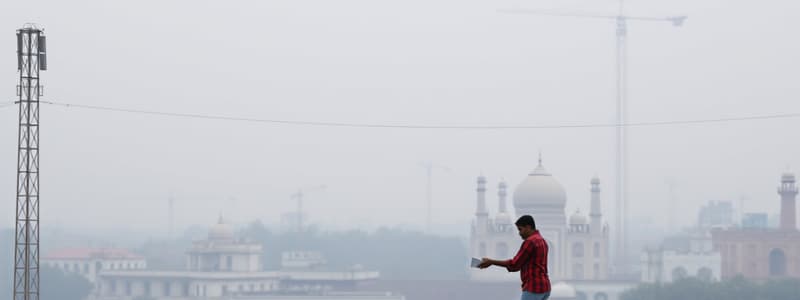Podcast
Questions and Answers
What were the three pillars of India's economic reforms initiated in 1991?
What were the three pillars of India's economic reforms initiated in 1991?
- Regulation, Export promotion, Import controls
- Industrialization, Nationalization, Protectionism
- Privatization, Liberalization, Globalization (correct)
- Foreign Aid, Investment, Tariffs
In what year did India celebrate the 25th anniversary of its economic reforms?
In what year did India celebrate the 25th anniversary of its economic reforms?
2016
What was India’s annual growth rate in 2016?
What was India’s annual growth rate in 2016?
7.6 percent
India's foreign exchange reserves were sufficient to sustain two weeks of imports in July 1991.
India's foreign exchange reserves were sufficient to sustain two weeks of imports in July 1991.
The economic reforms in India were initiated as a result of a severe fiscal deficit-driven ______ crisis.
The economic reforms in India were initiated as a result of a severe fiscal deficit-driven ______ crisis.
What contributed to the rise in trade deficit from $356 million to $677 million per month in the early 1990s?
What contributed to the rise in trade deficit from $356 million to $677 million per month in the early 1990s?
Before 1990/91, India had an open economy.
Before 1990/91, India had an open economy.
Flashcards are hidden until you start studying
Study Notes
Economic Reforms in India
- 2016 marked the 25th anniversary of India's economic reforms initiated in 1991 due to a severe fiscal deficit-driven balance of payments crisis.
- The reforms focused on three main pillars: privatization, liberalization, and globalization, breaking the "Hindu growth rate" cycle of low economic growth pre-reforms.
- By 2016, India's economy had become the fastest-growing globally with a growth rate of 7.6%, surpassing China's 6.9%.
Macroeconomic Indicators and Performance
- India's finance minister projected an annual growth rate of 8.5% for 2016/17, highlighting robust macroeconomic performance.
- The turnaround over 25 years illustrates significant improvements in macroeconomic stability and growth.
Background of the Economic Crisis
- Prior to 1991, India operated as a closed economy, facing a critical balance of payments crisis with foreign exchange reserves plummeting to under $1 billion by July 1991.
- The Gulf War caused oil prices to surge, contributing to an increased trade deficit—oil import costs rose from $287 million/month to $671 million/month in less than a year.
- Key factors worsening the crisis included the loss of exports to Iraq and Kuwait and decreased remittance flows from Indians in the region.
Financial Instability and Confidence Crisis
- The capital account changes mirrored a deteriorating trade account and contributed to a crisis of confidence in government management of the economy.
- India faced significant outflows of funds, including nearly $952 million in non-resident Indian deposits during April–June 1991 due to falling credit ratings and rising costs of borrowing.
Studying That Suits You
Use AI to generate personalized quizzes and flashcards to suit your learning preferences.




